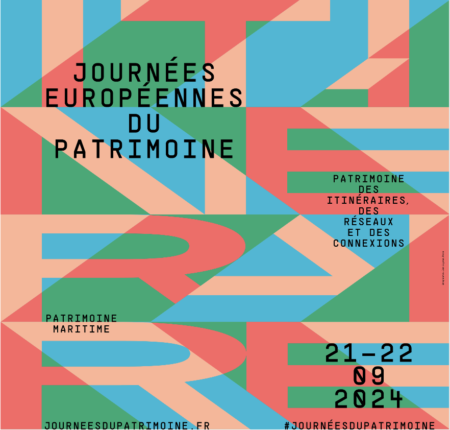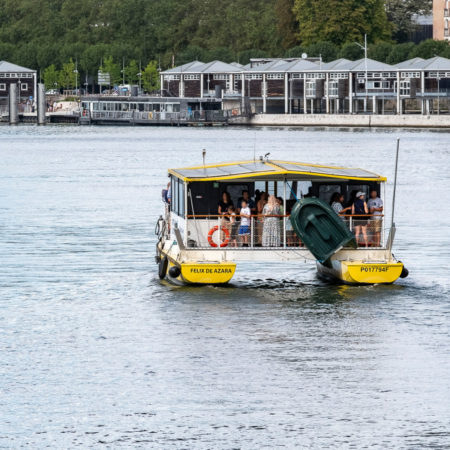
Atelier Shazak, réinventer les savoir-faire traditionnels du cuir.

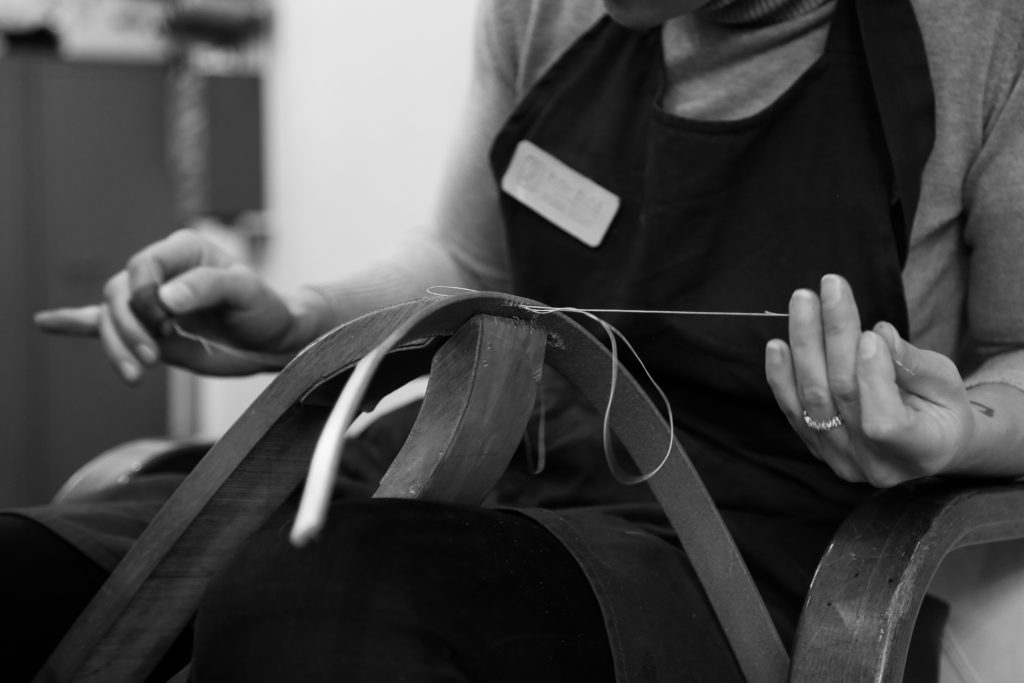
Shazak est l’acronyme de l’artisan d’art Sofia Haccoun-Zakabloukowa, sellier-harnacheur et garnisseur. Formée par les Compagnons du Devoir, elle fonde son atelier en 2016 et s’installe en septembre 2022 au JAD. Spécialisée dans le travail du cuir sur mesure, elle défend une approche expérimentale du matériau, tant sur le plan esthétique que technique, tout en perpétuant le métier de sellier. Une activité mixte qui se traduit dans son actualité.
Depuis le 19 octobre et jusqu’au 17 décembre, Sofia Haccoun-Zakabloukowa expose trois pièces de harnachement dans le cadre de l’exposition Sur la route des Jeux, à la Celle Saint-Cloud. En parallèle, les projets de collaboration qu’elle porte avec d’autres créateurs du JAD, sont présentés dans l’exposition Pages Blanches. Exposition manifeste du JAD, celle-ci met en lumière les projets de recherches et d’innovations collaboratives auxquels ses artisans d’art et designers œuvrent depuis près d’un an.
Vous exposez plusieurs pièces de harnachement dans l’exposition Sur la route des Jeux à La Celle Saint-Cloud. Quel est le propos de cette exposition et quelles sont les spécificités des pièces que vous y exposez ?
A quelques mois des Jeux Olympiques 2024, la Direction des Affaires Culturelles de la ville a profité de sa proximité géographique avec Versailles – qui accueillera les jeux équestres – pour présenter les travaux d’artistes et de créateurs en lien avec le monde du cheval et des sports équestres. Y sont ainsi exposées les créations de peintres, sculpteurs et photographes, portant un regard artistique sur l’équitation. En parallèle, le commissariat de l’exposition a fait le choix de mettre en avant les savoir-faire artisanaux liés au cheval, en présentant trois de mes créations.
La première est un bridon : une pièce de harnachement qui s’attache à la tête du cheval et qui sert à le diriger, que j’avais déjà exposé dans Matières à Pensées, l’exposition inaugurale du JAD. La deuxième est une selle de dressage que j’ai réalisée cet été. Enfin, la troisième – et la plus intéressante selon moi – est une pièce de shallang, un élément ornemental qui se fixe sur la partie frontale du bridon et qui, à l’origine, avait une fonction de chasse-mouche. Cette pièce a la spécificité d’avoir été réalisée à partir d’une tradition de tressage de cuir hongroise qui consiste en un complexe système de laçage incisé.
Pour la réaliser, j’ai dû mener un long et fastidieux travail de reconstitution, qui a été d’autant plus intéressant que je n’ai trouvé aucune archive écrite expliquant cette technique. Il a donc fallu que je m’appuie sur des photographies anciennes et que je multiplie les tentatives pour parvenir à la reproduire et à la maîtriser avec suffisamment d’aisance pour laisser libre cours à ma créativité.
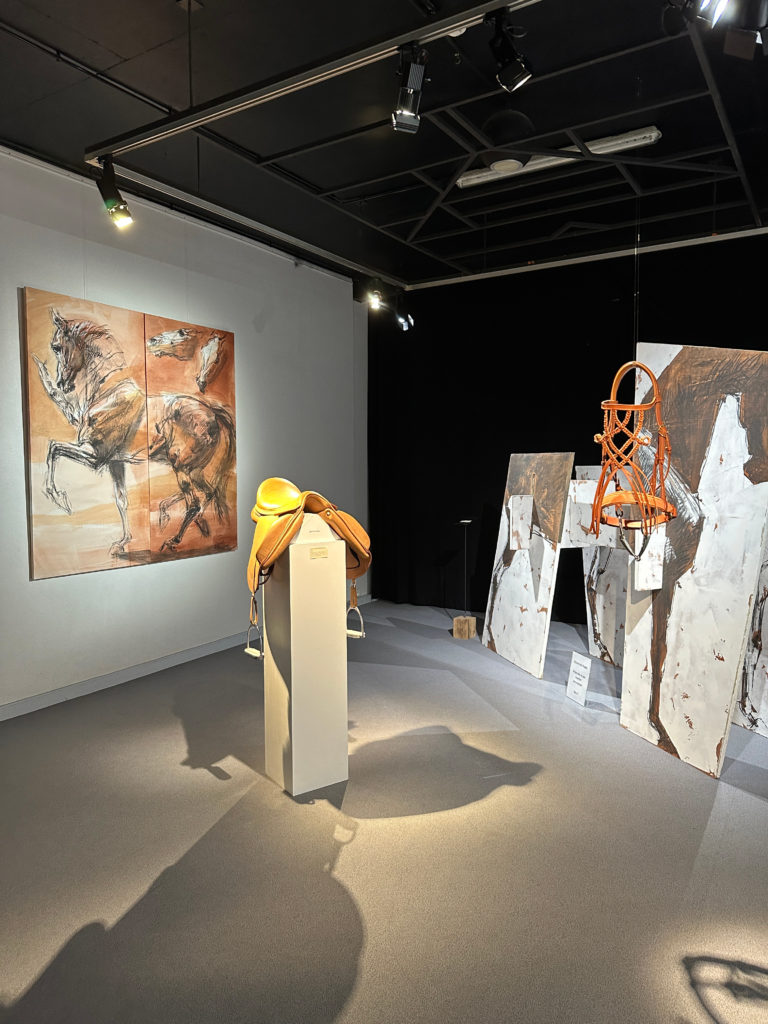
Crédits photos : Atelier Shazak
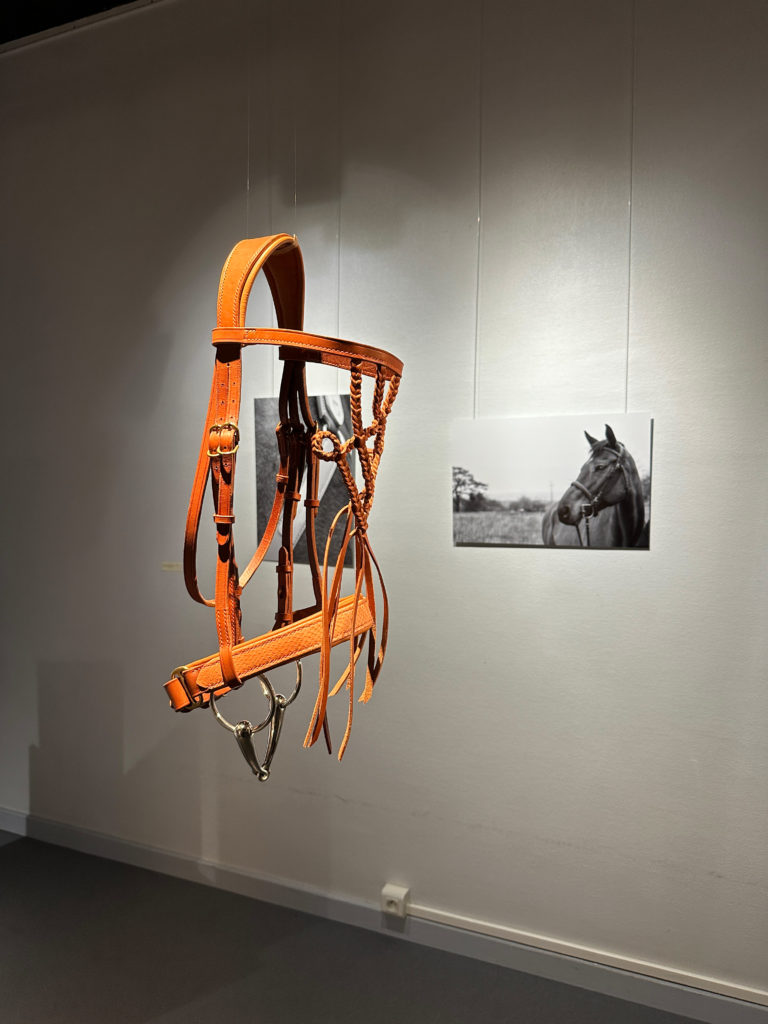
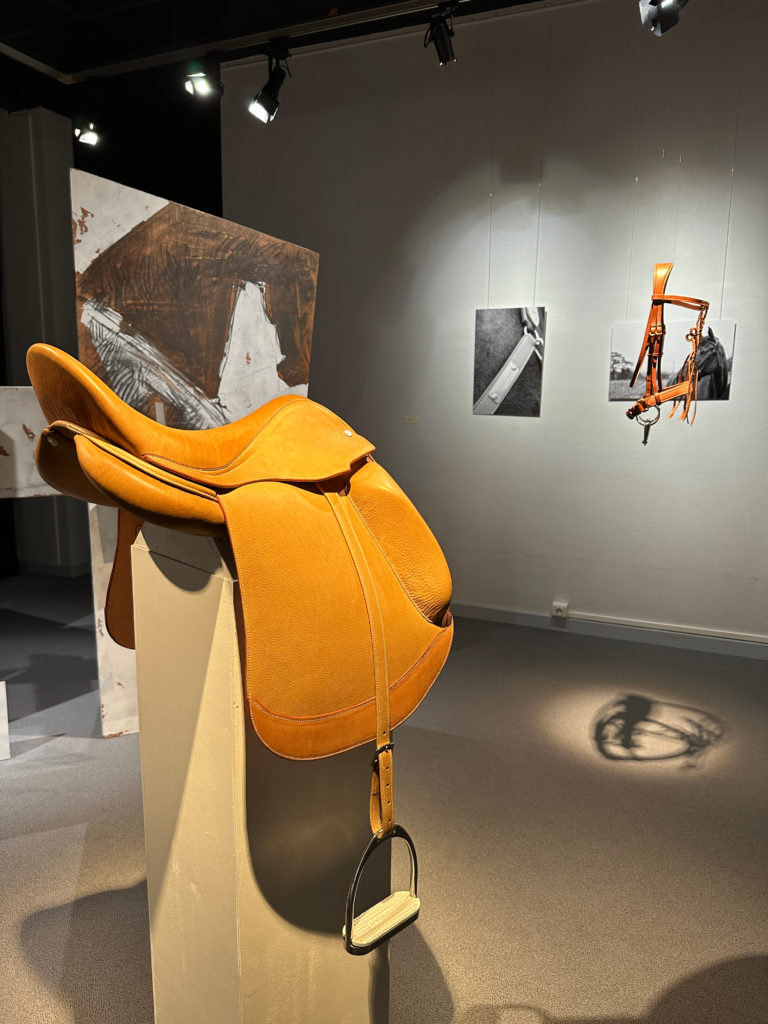
Le métier de sellier n’est pas courant. Comment en êtes-vous arrivée à choisir ce savoir-faire et le travail du cuir ?
Mon histoire avec la sellerie prend racine dans ma passion pour le cheval. Depuis toute petite, je pratique l’équitation et notamment en compétition, mais toujours pour le plaisir. J’ai donc eu très tôt, par ce biais, un contact avec le cuir. Mais à cette époque-là, il n’était pas question que j’en fasse un métier et à aucun moment, notamment lors du choix de mon orientation professionnelle, le travail manuel ne m’a été présenté ou ne m’est apparu comme une option. C’est lors de mon service militaire à l’étranger que j’ai découvert que je savais faire des choses de mes mains, et que j’ai pris conscience que j’aimais profondément cela. A mon retour en France, cette idée a fait son chemin, et c’est donc assez naturellement que je me suis tournée, quelques années plus tard, vers la sellerie et les Compagnons du Devoir, animée par ma passion pour l’équitation, et mue par la volonté d’appartenir à une communauté d’artisans.
Après plusieurs années de formation à la sellerie générale, j’ai poursuivi mon apprentissage en autodidacte afin de maîtriser également les techniques propres au harnachement. Ainsi, en plus de la réalisation de sièges, coussins, panneaux muraux et autres habillages intérieurs en cuir ou revêtements synthétiques, j’ai rapidement pu réaliser toutes les pièces de cuir utilisées pour la conduite d’un attelage et l’équipement d’un cheval comme les selles, les harnais, les traits et autres accessoires principalement dédiés à l’équitation.
Aujourd’hui, votre pratique ne se limite pas à la sellerie dans son acception traditionnelle. Comment ce déploiement de votre activité s’est-il opéré ? Comment êtes-vous passée d’une pratique “traditionnelle” de la sellerie à celle d’une créatrice travaillant en dialogue avec des designers ?
Après la création de l’Atelier Shazak, j’ai notamment eu un atelier-boutique à Saint-Cloud. Cela a été certes des années très formatrices, mais au cours desquelles j’ai manqué de temps pour la création, la recherche et l’expérimentation. Or, ce qui m’importe le plus dans ma pratique c’est justement de développer mon savoir-faire, de le faire dialoguer avec d’autres matériaux, d’autres techniques, afin de le mettre en valeur et de le faire entrer de plain-pied dans le champ de la création contemporaine.
C’est dans cette perspective que j’ai intégré le Jardin des métiers d’Art et du Design. Je cherchais en effet un nouveau souffle pour m’aider à remettre la création au centre de mon activité. La proximité avec les autres artisans d’art et les designers du JAD était quant à elle la promesse de projets de collaboration. Pour moi ces projets sont autant d’occasions d’ouvrir mon savoir-faire à d’autres univers de création et à de nouveaux champs d’application, de la mode aux objets décoratifs en passant par la mise au point de nouveaux matériaux. Les panneaux décoratifs de marqueterie associant cuir et plumes, réalisés avec Marion Gouez, designer textile au JAD, et qui sont actuellement présentés dans l’exposition Pages Blanches, incarnent ce tournant dans mon activité.

Crédits photo : Léo Sexer
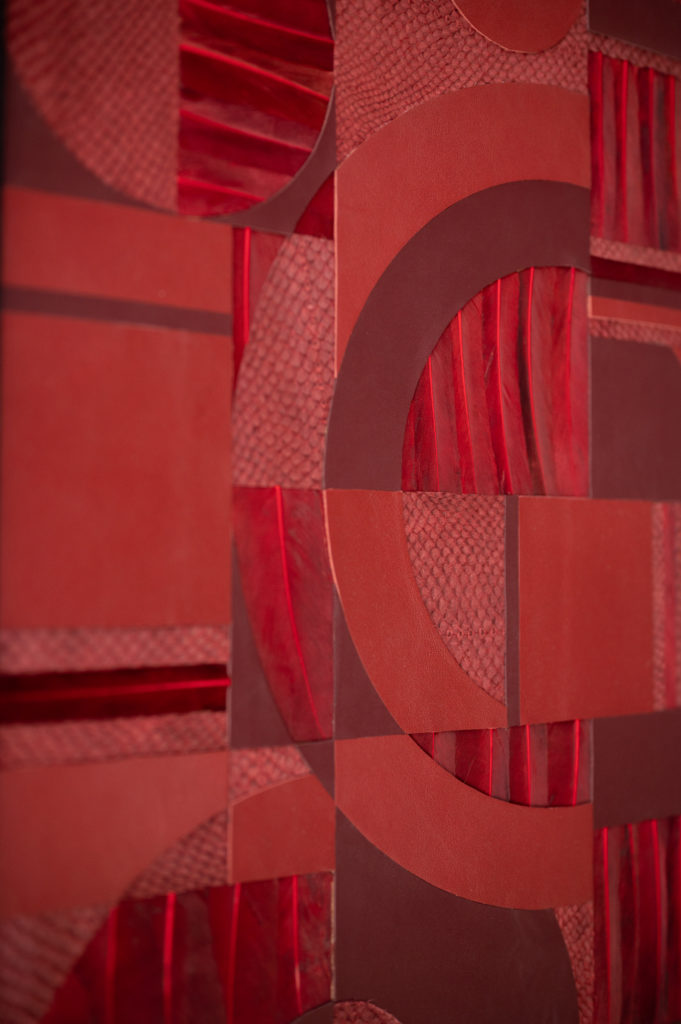
C’est aussi dans cette perspective que j’ai récemment réalisé un décolleté de robe en cuir moulé pour la maison Mugler, portée par la chanteuse colombienne Karol G, lors du gala du Business of Fashion. A travers ce type de commande, ce qui m’intéresse c’est de me faire l’interprète d’une vision créative, de traduire sur le plan technique des intentions esthétiques, et de le faire en y mettant ma sensibilité.
Néanmoins, je constate souvent que pour faire naître ces collaborations, et pour faire venir à moi des créateurs, il y a un véritable travail de sensibilisation au métier de sellier-harnacheur et garnisseur à mener. La sellerie est en effet un savoir-faire traditionnel relativement confidentiel, qu’il faut faire connaître et rendre intelligible pour que tout le panel de techniques qu’il recouvre et son potentiel sur le plan de la création soient exploités à leur juste mesure.
En parallèle, je développe aussi des créations plus personnelles, liées à mon héritage familial. Inspirées de formes issues du vivant, et en particulier du corps humain, les pièces que je crée sont, pour la plupart, réalisées par la mise en volume du cuir grâce à la technique de moulage. Une recherche technique qui se double d’une démarche sensible, à travers laquelle je cherche à retranscrire le mouvement ou le caractère vivant des sujets représentés.
Le sourçage de vos matériaux et leur réemploi sont également au cœur de votre activité. Comment cet engagement se traduit-il concrètement ?
Le sourçage de mes cuirs est en effet une facette importante de mon travail. Les matériaux que j’utilise proviennent pour 90% d’entre eux d’Europe et sont issus du recyclage alimentaire. Par ailleurs, pour les projets qui nécessitent l’emploi de cuirs exotiques, je n’utilise que des cuirs sourcés et refuse de travailler des peaux d’élevage. Enfin, je travaille principalement des cuirs à tannage végétal, beaucoup moins nocifs que le tannage au chrome qui est un véritable désastre écologique et humanitaire.
Par ailleurs, en parallèle, nous travaillons avec Cédric Breisacher, designer et sculpteur sur bois au JAD, à l’élaboration d’un nouveau matériau, issu de la compression des rebuts de cuir produits en atelier. Une recherche qui repose sur ma connaissance et ma sensibilité au matériau, et qui s’appuie sur la méthode de création de matière appliquée au travail du bois mis au point par Cédric Breisacher. Cette recherche, est aussi présentée dans l’exposition Pages Blanches du JAD, n’en est qu’à ses prémices. Elle pourrait cependant, à terme, aboutir sur la mise au point d’une méthode de valorisation de ces déchets qui sont estimés à près de 800 000 tonnes par an à l’échelle mondiale. Ce projet offre aussi de nouvelles perspectives pour le travail du cuir car, une fois mis en volume, celui-ci pourrait être taillé ou sculpté dans la masse, ouvrant ainsi le matériau à de nouvelles formes, une nouvelle esthétique et de nouvelles applications.
Informations pratiques
Sur la route des Jeux
Exposition présentée du 19 octobre au 17 décembre 2023
Salle d’exposition de l’Hôtel de Ville de la Celle Saint-Cloud
8E avenue Charles de Gaulle, 78170 La Celle Saint-Cloud
Entrée libre du mercredi au dimanche de 15h à 18h
Pages Blanches
Exposition présentée du 14 septembre au 03 décembre 2023
Jardin des métiers d’Art et du Design
6 Grande Rue, 92310 Sèvres
Entrée libre du mercredi au dimanche de 14h à 19h
Sur la même thématique

Une navette fluviale pour venir au JAD
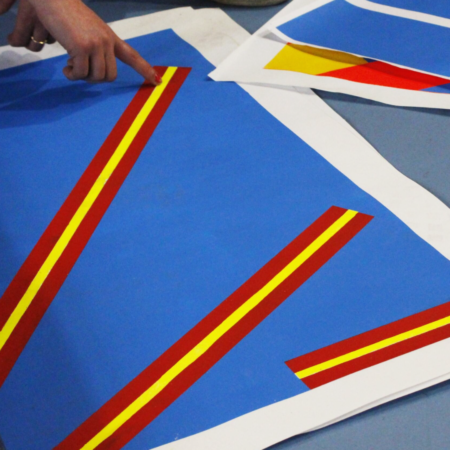
Restitution du programme Handesign

Cédric Breisacher et Marion Gouez, lauréats de la Bourse MIRA 2024 : récit d'une collaboration
